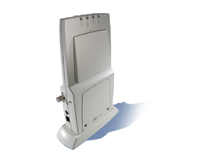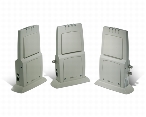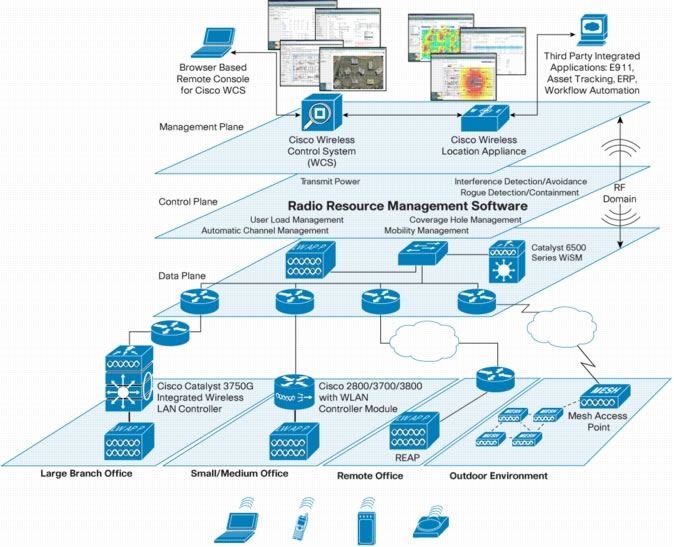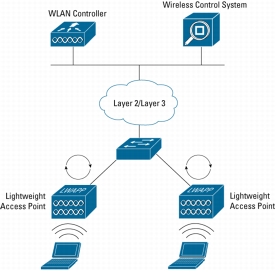+7 (812) 929-8283
Cisco Aironet 1000

"Облегченная" точка доступа Cisco Aironet серии 1000 (Cisco Aironet 1000 Series Lightweight Access Point) представляет собой двухдиапазонную точку доступа, поддерживающую стандарт 802.11 a/b/g и не требующую вмешательства оператора в процессе настройки и эксплуатации. Она может служить в качестве защищенного, экономичного средства доступа к беспроводной сети и поддерживает мощные сервисы WLAN для корпоративных сетей. Предлагаемая "облегченная" точка доступа поддерживает передовые радиочастотные функции и допускает различные варианты установки. Это позволяет повысить уровень производительности, защищенности, надежности и масштабируемости беспроводной сети. Это устройство не только удовлетворяет эксплуатационным требованиям для самых сложных корпоративных сред, но и превосходит их.
Точка доступа Cisco Aironet серии 1000 функционирует в сочетании с контроллером беспроводной сети Cisco (Cisco Wireless LAN Controller) и опциональной системой контроля беспроводных сетей Cisco (Cisco Wireless Control System, WCS). Это позволяет обеспечить одновременное выполнение функций пересылки данных и мониторинга за состоянием эфирной среды. Помимо доставки трафика данная точка доступа реализует также функции управления радиочастотами в реальном времени и защиты от вторжений. Это решение избавляет от необходимости использовать дополнительные выделенные узлы мониторинга, что позволяет сократить затраты, связанные с развертыванием сети WLAN, и упростить ее архитектуру. Поддержка Cisco Aironet серии 1000 протоколов Wi-Fi Protected Access (WPA) и 802.11i/WPA2 позволяет реализовать совместимую с другими устройствами схему безопасности сети WLAN корпоративного класса.
Данная модель поставляется либо в варианте с внутренней антенной, либо с разъемом для подключения внешней антенны. Второй вариант, как правило, используется в сложных радиочастотных средах. Уникальная версия серии 1000 Series, точка доступа Cisco Aironet 1000 Series Remote Edge, предлагает экономичный вариант поддержки интеллектуальных сервисов WLAN в удаленных офисах.
Общая архитектура построения беспроводных сетей Cisco Unified Wireless Network
Архитектура Cisco Unified Wireless Network обладает превосходными характеристиками в области безопасности, управляемости, функциональности и радио-частотной эффективности для предоставления беспроводного доступа к корпоративным приложениям.Безопасность беспроводных сетей
Безопасность беспроводных сетей может быть обеспечена на очень высоком уровне. Узнайте больше о том, как это сделать стандартными средствами, а также о продуктах Cisco, позволяющих перейти на новый уровень контроля и защиты корпоративной беспроводной сети.
Cisco Aironet 1000 Series Lightweight Access Points
Cisco Aironet 1000 Series Lightweight Access Points provide industry-leading RF capabilities with the widest breadth of deployment options for maximum wireless LAN performance, security, reliability, and ease of use. This makes the Cisco wireless LAN solution ideally suited for any enterprise environment.
Figure 1. Cisco Aironet 1000 Series Lightweight Access Points

Cisco® Aironet 1000 Series lightweight access points are specifically designed for operation with Cisco Wireless LAN Controllers and the Wireless Control System management tool. They provide dual band support for both 802.11a, 802.11b and 802.11g, simultaneous air monitoring for dynamic, real time RF management. In addition, Cisco Aironet 1000 Series Lightweight Access Points handle time-sensitive functions, such as Layer 2 encryption, that enable Cisco wireless LANs to securely support voice, video, and data applications (Figure 2).
Figure 2. Enterprise-Wide RF Intelligence

Cisco Aironet 1000 Series Lightweight Access Points combine simultaneous data forwarding and air monitoring functions eliminating the need for additional dedicated monitoring nodes and thereby reducing the cost of operating wireless networks. This simplifies network design and deployment and maximizes RF security by extending real-time monitoring to every corner of a wireless infrastructure (Figure 3).
Figure 3. Integrated Air Monitoring and Data Services

FLEXIBLE DEPLOYMENT OPTIONS
Cisco Aironet 1000 Series Lightweight Access Points come equipped with internal 2.4 and 5GHz radios and sectorized antennas, with the 1020 and 1030 models supporting RP-TNC connectors to connect optional external antennas. Cisco Aironet 1000 Series Lightweight Access Points are also available with a single 2.4 GHz radio, for installations where 5 GHz is not allowed due to regulatory restrictions. Multimode 802.11 a/b/g access points provide maximum deployment flexibility and investment protection. In addition, all models are UL 2043 rated to accommodate nearly all building deployment scenarios, such as installation in plenum air spaces. These devices support IEEE 802.3af Power over Ethernet (PoE) and auto MDI/MDIX, and offer standards-based, "over the air" quality of service (QoS), providing additional deployment flexibility. Using the Lightweight Access Point Protocol (LWAPP), Cisco lightweight access points can automatically detect the best available Cisco wireless LAN controller and download appropriate policies and configuration information with no hands-on intervention.
The Cisco Aironet 1000 Series consists of three access points each featuring dual 2.4 and 5 GHz radios supporting 802.11a, 802.11b and 802.11g. In addition it is available with a single 2.4 GHz radio that supports 802.11g and 802.11b, for installations where 5 GHz is not allowed due to regulatory restrictions. All interoperate with Cisco Wireless LAN Controllers and the Wireless Control System management tool. Each are optimized for different application scenarios:
The AP1010 features dual integrated sector antennas. It's designed for offices and similar environments providing easy deployment and a predictable coverage pattern.
The AP1020 features both integrated sector antennas and an RP-TNC connector for external antennas. By selecting from a wide range of Cisco antennas, customers can achieve a variety of coverage shapes and sizes. Designed for more challenging RF environments, the AP1020 provides a high degree of installation flexibility.
The AP1030 features both integrated sector antennas and an RP-TNC connector for external antennas and an expanded set of software features designed for a variety of specific applications.
- Remote Edge Access Point (REAP) capabilities allow the AP1030 to be deployed remotely from the wireless LAN controller making it ideal for branch office and small retail locations. The AP1030 delivers the same LAN security, performance, and RF management capabilities as the AP1010 and 1020 and can operate via most standard WAN technologies, including T1, Frame Relay, ATM, DSL, ISDN, and switched 56k. These capabilities enable IT managers to centrally control SSIDs, security parameters, and software loads for unified, enterprise wide wireless LAN services.
- Wireless backhaul capabilities are ideal for applications where an access point is deployed in a location where access to Ethernet is either impossible or impractical. With the AP1030, customers can configure either of the internal radios as a wireless uplink which associates directly with a traditional (root) access point with a wired uplink. Wireless backhaul capabilities are ideal for applications including factories, warehouses, aircraft and dirigible hangers and relatively small outdoor deployments.
- Point-to-Point and Point-to-Multipoint bridging functionality is supported. With this application, each Cisco 1030 Access Point's Ethernet interface is plugged into a wired network while either the 2.4 or 5GHz RF interface associates wirelessly and joins the networks into a single managed domain*. With optional external antennas ranges of up to one mile (1.6 kilometers), the AP1030 is often an inexpensive alternative to cables and T-1 lines for joining permanent and temporary campus facilities together.
Note: The Cisco Aironet 1000 Series Lightweight Access Point with a single 2.4 GHz radio does not support bridging functionality.
APPLICATIONS
Designed for enterprise environments and deployments that require coverage flexibility, specific models of Cisco Aironet 1000 Series Lightweight Access Points feature multiple antenna, range, and installation options. A university campus, for example, may place wireless LANs in classrooms using Cisco 1010 lightweight access points. For auditoriums and common areas, Cisco 1020 lightweight access points would be deployed with higher gain external antennas for extended range or specialized coverage patterns
In larger enterprise wireless LAN deployments with many access points, IT staff can easily perform software upgrades to Cisco Aironet 1000 Series Lightweight Access Points. Changes are automatically pushed to all access points from Cisco wireless LAN controllers, providing smooth and cost-effective upgrades and helping to ensure that new wireless standards can be supported with no hands-on intervention of the access point. This capability also helps ensure interoperability throughout the network-software automatically remains consistent across the entire Cisco wireless LAN system.
FEATURES AND BENEFITS
Table 1 lists the features and benefits of Cisco Aironet 1000 Series Lightweight Access Points.
Table 1. Features and Benefits of Cisco Aironet 1000 Series Lightweight Access Points
| Feature | Benefit |
|---|---|
| Standards-Based LWAPP | |
| Zero-Touch Configuration and Management | |
| Simultaneous Air Monitoring and Data Service | |
| Internal and External Antenna Options | |
| Security | |
| QoS |
SUMMARY
Cisco Aironet 1000 Series Lightweight Access Points are ideal for enterprise deployments. Dual 802.11a and 802.11b/g radios and integrated antennas provide flexibility for users to meet the performance requirements of the most demanding applications, while security and management capabilities provide uncompromised support for interoperable IEEE 80211i security and ease of deployment. Cisco Aironet 1000 Series Lightweight Access Points are available with a single 2.4 GHz radio, for installations where 5 GHz is not allowed due to regulatory restrictions. The Cisco 1010 provides integrated antennas to simplify deployments. The Cisco 1020 features RP-TNC antenna connectors for extended range coverage versatility using a broad range of optional external antennas. The Cisco 1030 is the ideal solution for linking remote sites or remote offices which are connected to centralized WLAN controllers. For enterprise environments, the Cisco Aironet 1000 Series Lightweight Access Points are the industry leading access point for secure, scalable, enterprise-class wireless LANs.
PRODUCT SPECIFICATIONS
Table 2 lists the product specifications for Cisco Aironet 1000 Series Lightweight Access Points.
Table 2. Product Specifications for Cisco Aironet 1000 Series Lightweight Access Points
| Item | Specification | ||
|---|---|---|---|
| Data Rates Supported |
|
||
| Uplink |
|
||
| Frequency Band and Operating Channels |
|
||
| Nonoverlapping Channels |
|
||
| Wireless Modulation |
|
||
| Receive Sensitivity (Typical) | 802.11a: |
802.11b: |
802.11g: |
| Available Transmit Power Settings |
|
||
| Range |
|
||
| Antenna Connectors |
|
||
| Integrated Antennas |
|
||
| Interface and Indicators |
|
||
| Dimensions (H x W x D) |
|
||
| Weight |
|
||
| Environmental |
|
||
| Power |
|
||
| Warranty |
|
||
| Wi-Fi Certification |
|
||

